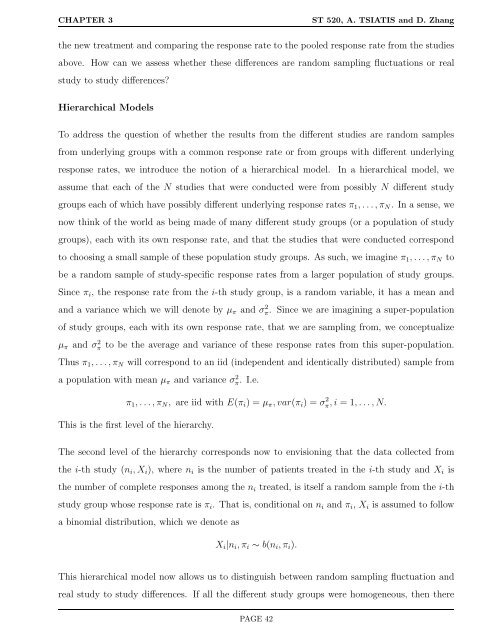ST 520 Statistical Principles of Clinical Trials - NCSU Statistics ...
ST 520 Statistical Principles of Clinical Trials - NCSU Statistics ...
ST 520 Statistical Principles of Clinical Trials - NCSU Statistics ...
You also want an ePaper? Increase the reach of your titles
YUMPU automatically turns print PDFs into web optimized ePapers that Google loves.
CHAPTER 3 <strong>ST</strong> <strong>520</strong>, A. TSIATIS and D. Zhang<br />
the new treatment and comparing the response rate to the pooled response rate from the studies<br />
above. How can we assess whether these differences are random sampling fluctuations or real<br />
study to study differences?<br />
Hierarchical Models<br />
To address the question <strong>of</strong> whether the results from the different studies are random samples<br />
from underlying groups with a common response rate or from groups with different underlying<br />
response rates, we introduce the notion <strong>of</strong> a hierarchical model. In a hierarchical model, we<br />
assume that each <strong>of</strong> the N studies that were conducted were from possibly N different study<br />
groups each <strong>of</strong> which have possibly different underlying response rates π1, . . ., πN. In a sense, we<br />
now think <strong>of</strong> the world as being made <strong>of</strong> many different study groups (or a population <strong>of</strong> study<br />
groups), each with its own response rate, and that the studies that were conducted correspond<br />
to choosing a small sample <strong>of</strong> these population study groups. As such, we imagine π1, . . .,πN to<br />
be a random sample <strong>of</strong> study-specific response rates from a larger population <strong>of</strong> study groups.<br />
Since πi, the response rate from the i-th study group, is a random variable, it has a mean and<br />
and a variance which we will denote by µπ and σ 2 π. Since we are imagining a super-population<br />
<strong>of</strong> study groups, each with its own response rate, that we are sampling from, we conceptualize<br />
µπ and σ 2 π to be the average and variance <strong>of</strong> these response rates from this super-population.<br />
Thus π1, . . .,πN will correspond to an iid (independent and identically distributed) sample from<br />
a population with mean µπ and variance σ2 π . I.e.<br />
π1, . . .,πN, are iid with E(πi) = µπ, var(πi) = σ 2 π , i = 1, . . .,N.<br />
This is the first level <strong>of</strong> the hierarchy.<br />
The second level <strong>of</strong> the hierarchy corresponds now to envisioning that the data collected from<br />
the i-th study (ni, Xi), where ni is the number <strong>of</strong> patients treated in the i-th study and Xi is<br />
the number <strong>of</strong> complete responses among the ni treated, is itself a random sample from the i-th<br />
study group whose response rate is πi. That is, conditional on ni and πi, Xi is assumed to follow<br />
a binomial distribution, which we denote as<br />
Xi|ni, πi ∼ b(ni, πi).<br />
This hierarchical model now allows us to distinguish between random sampling fluctuation and<br />
real study to study differences. If all the different study groups were homogeneous, then there<br />
PAGE 42
















